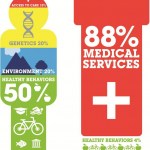built environment
It’s not unusual for studies on community walkability to face the perplexing question of self-selection. In other words, people who already like to walk end up moving to walkable communities and so those communities naturally have higher physical activity rates. In even simpler terms, it’s about the person, not the environment. However, a new study finds that walkable community design does influence healthy behavior — even among people with no preference for walking in the first place.
Published in December in a supplement of the Preventive Medicine journal, the study examined changes in…
It takes time to change social norms, so it'll probably take many, many years until it's as socially unacceptable to text or use a cell phone while driving as it is to start the engine without first buckling a seat belt. In the meantime, researchers say, smart policies are needed to address the increasing share of pedestrian and bicyclist deaths attributed to distracted driving.
According to a new study published in Public Health Reports, the rate of distracted driving-related fatalities per 10 billion vehicle miles traveled went up from 116.1 in 2005 to 168.6 in 2010 for pedestrians and from…
by Kim Krisberg
When most of us pass by a new high-rise or drive down a new road, we rarely think: Did the builders and planners consider my health? However, a new report from the U.S. Environmental Protection Agency offers evidence that certain types of land use and transportation decisions can indeed limit the human health and environmental impacts of development.
Released in mid-June, the publication is a revised and updated version of an EPA report initially published in 2001. Agency officials said the report was particularly timely as the nation's built environments are quickly changing…
by Kim Krisberg
It really is a chemical world, which is bad news for people with asthma.
According to a recent report released in August, at this very moment from where I write, I'm fairly surrounded by objects and materials that contain chemicals that are known or suspected asthmagens — substances that can act as asthma triggers if inhaled. There's formaldehyde (it's in office furniture, wood flooring, curtains and drapes); maleic anhydride (it's in interior paint and tile flooring); hexamethylene diisocyanate (it's in metal storage shelving and decorative metal); and diisodecyl phthalate (…
Via Ezra Klein, here's a striking infographic from the Bipartisan Policy Center comparing what makes us healthy to how we as a nation spend our health dollars:
Infographic from the Bipartisan Policy Center
As it illustrates, behaviors are major contributors to our health status, but a tiny fraction of US health spending goes to encouraging healthy behaviors like physical activity.
The Bipartisan Policy Center report Lots to Lose: How America's Health and Obesity Crisis Threatens our Economic Future offers several recommendations for improving nutrition and physical activity in the US. In…
As we try to figure out how to curb an unhealthy increase in obesity, one of the factors under consideration is the built environment. Those who in live in places where few destinations are within walking/biking distance, public transit is limited, and the environment is unfriendly to pedestrians and cyclists may find it harder to get the recommended amount of physical activity. Studying the built environment's effect on obesity is challenging, though. People who live in pedestrian-friendly areas with good public transit may be more likely to get enough activity and less likely to be obese…
